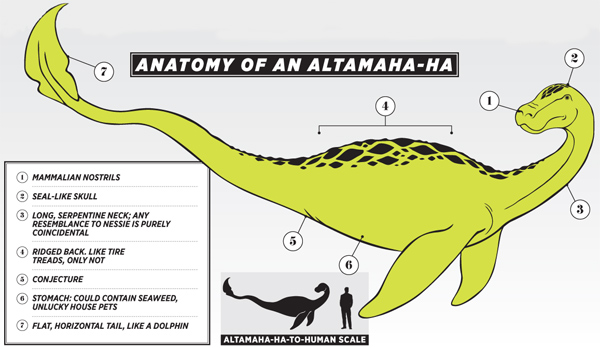A word about cryptolinks: we are not responsible for the content of cryptolinks, which are merely links to outside articles that we think are interesting (sometimes for the wrong reasons), usually posted up without any comment whatsoever from me. 

An alligator spies on my family as we stand on a midden heap on a muddy bank of the South Altamaha River. Our flip-flops crunch on the jagged oyster shells and pottery shards cast off by Native Americans a couple of centuries ago. Our guide points out their importance to the history of coastal Georgia, but I can’t pay proper attention. I’ve brought my family to Darien in search of a monster.
Squinting in the midday sun, I can see the alligator’s eyes and snout protruding from the water about 50 yards away. Our guide, Danny Grissette, says it’s 8 to 9 feet long, making it no match for my potential prey, an aquatic beast alleged to be at least 20 feet in length. Wait, could that be the creature’s famed ridged hump? No, it’s just a stump sticking out of the brown river water. What about that mysterious turbulence about 25 yards away? It could be the wake of an unseen ship or a school of fish. But can we prove that it’s not the tell-tale sign of the legendary entity known as the Altamaha-ha?
The Altamaha-ha, known more casually as “Altie,” defies scientific explanation. Even before European settlement, the Tama tribes people told stories of a giant, snake-like river animal that hissed and bellowed. Over the past century, fishermen, lumberjacks and boy scouts have reported sightings of a creature in the tributaries and marshes of the Altamaha River, which feeds one of the largest river basins on the Atlantic Coast. The eyewitness consensus holds that the Altamaha-ha has a dark, smooth hide, apart from the tire-tread-like ridges on its back, as well as a narrow neck, prominent snout and flat, porpoise-like tail.


















No comments:
Post a Comment